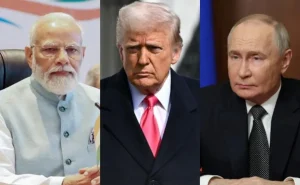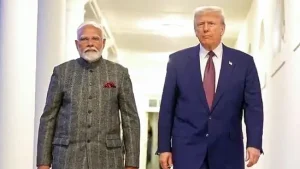Washington D.C. – India and the United States are nearing completion of a long-stalled India US trade deal that would dramatically reduce American tariffs on Indian imports from the current punitive rate of 50 percent to just 15-16 percent. This significant breakthrough in bilateral negotiations comes after months of intensive discussions between the two countries, with sources familiar with the matter confirming substantial progress on key contentious issues.
The India US trade deal framework hinges primarily on energy and agriculture sectors, with New Delhi agreeing to gradually scale back its imports of Russian crude oil as part of the comprehensive package. This linkage between trade concessions and geopolitical considerations reflects the complex nature of contemporary international commerce and diplomacy.
Trump-Modi Discussions Focus on Trade

US President Donald Trump confirmed on Tuesday that he spoke with Prime Minister Narendra Modi, with their discussion largely focused on advancing the India US trade deal. Trump stated that energy formed a significant part of their conversation, claiming Modi assured him that India would limit its oil purchases from Russia as part of the broader agreement framework.
“I just spoke to your prime minister today. We had a great conversation. We talked about trade,” Trump said while hosting a Diwali celebration at the White House. “We talked about a lot of things, but mostly the world of trade — he is very interested in that,” the President added, emphasizing the centrality of the India US trade deal to bilateral relations.
Russian Oil Factor in India US Trade Deal


India’s oil purchases from Russia had prompted a punitive levy of 25 percent on Indian exports, which came in addition to the 25 percent reciprocal tariffs announced in April. The total 50 percent tariff burden made the India US trade deal an urgent priority for New Delhi, as it significantly impacted Indian exporters across multiple sectors.
Currently, Russia supplies approximately 34 percent of India’s crude oil imports, while around 10 percent of the country’s oil and gas requirements by value come from the United States. The India US trade deal envisions a gradual rebalancing of these energy relationships, though the specifics of the transition timeline remain under negotiation.
Agricultural Market Access Components
The India US trade deal may see India opening its markets further to non-genetically modified American corn and soymeal, addressing longstanding American demands for greater agricultural access. New Delhi is also advocating for a provision in the agreement allowing periodic reviews of tariffs and market access, ensuring the India US trade deal remains responsive to changing economic circumstances.
Also Read: Trump Diwali Celebration: Powerful Modi Praise and Oil Trade Claims
India is considering raising the quota for importing non-GM maize from the US while keeping the 15 percent duty unchanged. The current limit stands at 0.5 million tonnes annually, but the India US trade deal could expand this to meet growing domestic demand from the poultry feed, dairy, and ethanol sectors.
Ongoing Negotiations on Specific Products


“Talks are also advancing on permitting imports of non-GM soymeal for both human and livestock consumption. However, there is still no final clarity on tariff reductions for dairy products, including high-end cheese, even though it is a key demand from the US team,” said one official involved in the India US trade deal negotiations.
These remaining issues demonstrate that while the broad framework of the India US trade deal has been established, certain sector-specific details require further refinement before final agreement can be reached.
Energy Cooperation Framework
Under the India US trade deal, India may gradually reduce its reliance on Russian oil while allowing ethanol imports from the United States. Washington, in turn, is expected to offer concessions on energy trade, creating a mutually beneficial framework for cooperation in this critical sector.
Indian state-run oil firms may be informally guided to diversify crude sourcing toward the United States as part of the India US trade deal implementation. Officials have conveyed to Moscow that India will scale down Russian crude imports, though the US has yet to match the discounts offered by Russia, creating economic challenges for the transition.
Presidential Precondition on Russian Oil
President Trump has reportedly made curbing Russian oil imports a precondition for the India US trade deal, linking trade benefits directly to India’s willingness to reduce energy dependence on Moscow. This conditionality reflects Washington’s broader strategy of using economic incentives to shape allied nations’ relationships with Russia amid the ongoing Ukraine conflict.
Trump reiterated these claims Tuesday, stating: “He is not going to buy much oil from Russia. He wants to see that war end as much as I do. He wants to see the war end with Russia, Ukraine, and as you know, they’re not going to be buying too much oil,” referring to the commitments he believes are embedded in the India US trade deal.
Timing and Announcement Plans
Finalization of the India US trade deal is likely to be announced at the ASEAN Summit during a meeting between Donald Trump and Narendra Modi this month. This high-profile venue would provide appropriate diplomatic setting for unveiling what both sides hope will be a transformative agreement in bilateral economic relations.
India’s Response and Clarifications
India’s external affairs ministry has maintained they were not aware of specific conversations Trump referenced regarding Russian oil commitments. Officials have indicated that any effort to scale back Russian energy purchases would be a gradual process, and the Modi government has previously stated that the country would continue making those purchases if economically viable.
India became a major importer of Russian crude after the start of the Ukraine war in 2022, buying oil at significant discounts. Russian oil now comprises approximately one-third of India’s overall imports despite US pressure to curb these flows, making the energy provisions of the India US trade deal particularly sensitive.
The success of the India US trade deal will ultimately depend on whether both nations can balance their respective economic interests, geopolitical objectives, and domestic political considerations while maintaining the strategic partnership that has developed between the world’s two largest democracies.

